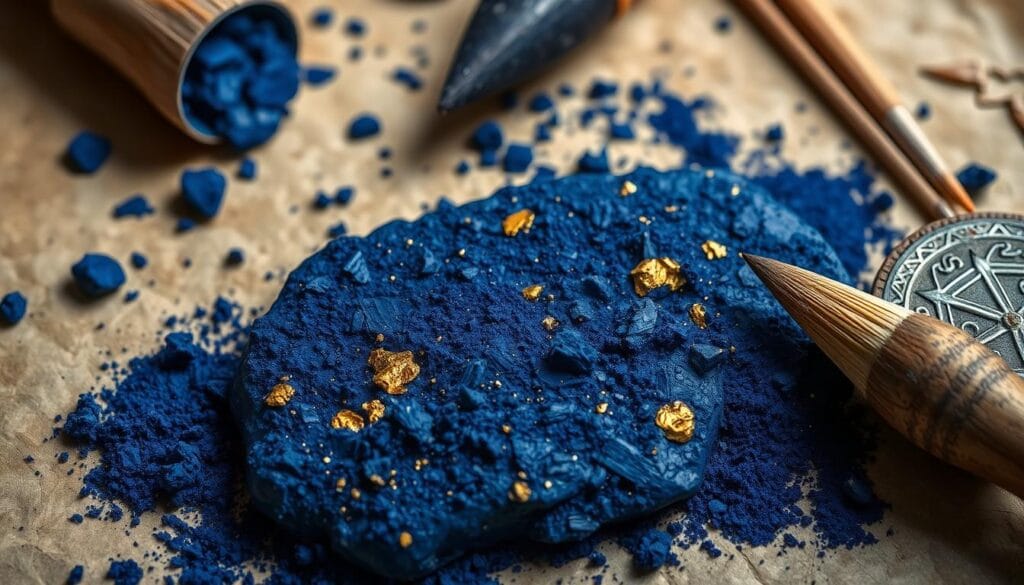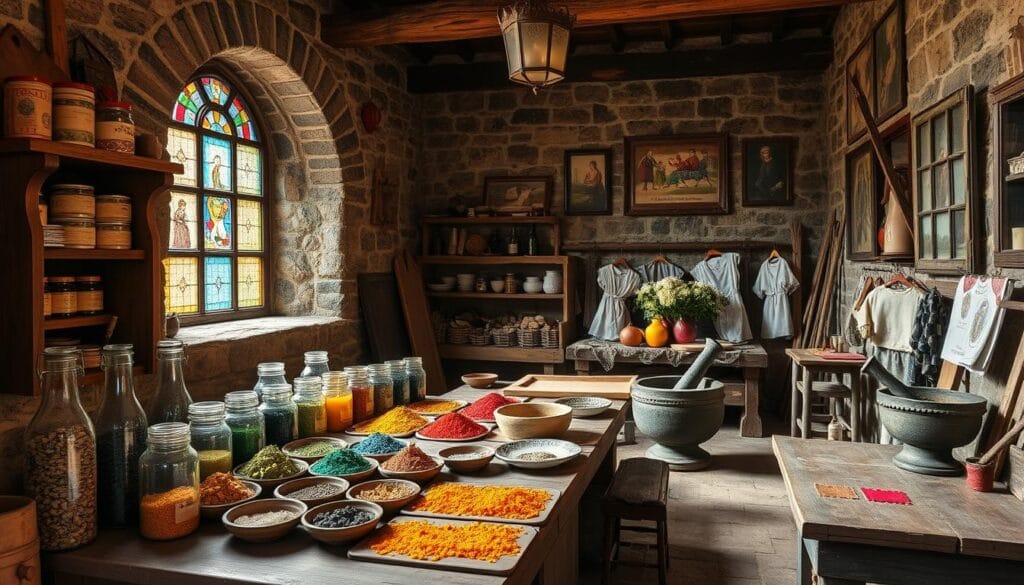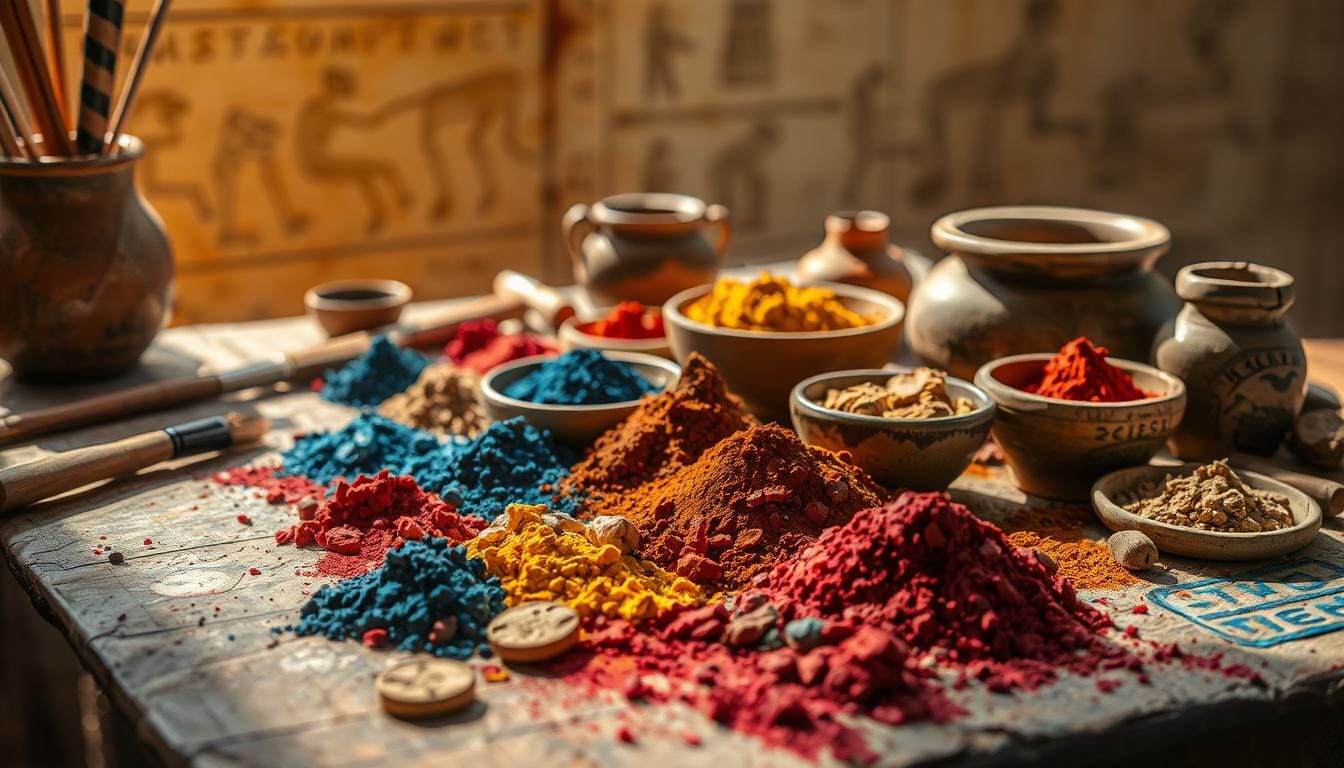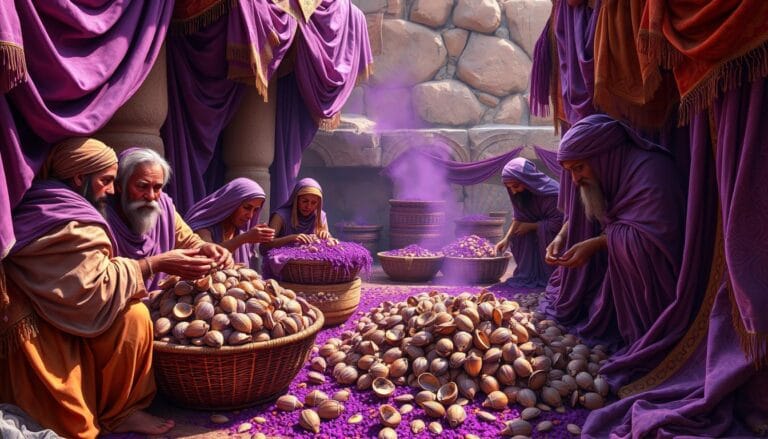The First Colors in Art: Ancient Pigments That Changed the World
Imagine standing before a cave wall, ready to create with ochre. These ancient artists were not just making pictures. They were starting a new way to express ourselves visually.
Color pigments have been telling our stories silently. They turned earth and plants into colors that speak to us today. These pigments show our creativity and how we’ve grown over time.
In the last 20 years, shows like “Gods in Color” have changed how we see ancient art. They show us that ancient art was full of color. This makes us rethink what we thought about ancient artists.
Understanding Ancient Pigments and Their Origins
Prehistoric art shows us a world of color creation. It started with natural pigments. Ancient artists found clever ways to make raw materials into vibrant art. Learning about pigments’ origins helps us see human creativity and innovation.
Pigments are key to art, turning simple materials into powerful visuals. In prehistoric times, artists used only natural pigments from their surroundings.
What Defines a Pigment
A pigment is a finely ground substance that adds color when mixed with a medium. It has a few important traits:
- Powder-like consistency
- Derived from natural or synthetic sources
- Ability to create permanent coloration
Natural vs Synthetic Sources
Ancient artists mainly used natural pigments from minerals, plants, and organic materials. These sources gave them a rich but limited color palette.
| Natural Source | Color | Origin |
|---|---|---|
| Red Ochre | Red/Brown | Iron-rich clay |
| Charcoal | Black | Burnt Wood |
| Chalk | White | Limestone Deposits |
The Role of Binders in Early Paint Making
Binders were key in making paints from natural pigments. Early artists tried different substances like:
- Animal fat
- Egg whites
- Plant-based oils
- Blood
*”Color is the keyboard, the eyes are the hammers, the soul is the piano with many strings.”* – Wassily Kandinsky
By learning about these ancient methods, we appreciate the creativity of prehistoric artists. They turned simple earth materials into amazing visual stories.
Prehistoric Cave Art: The Dawn of Color Expression
Imagine stepping back in time to when your ancestors first used cave paintings for storytelling. Over 40,000 years ago, early humans turned cave walls into amazing canvases. They used natural pigments like ochre and charcoal.
These ancient artists were very smart in their color choices and subjects. Research shows interesting facts about their art world:
- Animals made up 70% of cave art
- Human figures were in about 20% of paintings
- Abstract symbols were 10% of the art
The most common animals in cave art were mammoths, bison, horses, deer, and lions. These weren’t just random drawings. They were powerful symbols linked to hunting and spiritual beliefs.
“Art is older than civilization itself” – Unknown Prehistoric Artist
Charcoal and ochre were the main tools for these early artists. They got these pigments from nature, creating a deep bond with their surroundings. Places like Lascaux in France show incredible examples of their art.
By using simple materials, prehistoric humans created a visual language beyond words. Their cave paintings show not just skill but also a deep understanding of symbols and stories.
The First Colors in Art: From Earth to Canvas
Prehistoric artists found a hidden palette in the earth. They turned simple minerals into art that inspired many. This art changed the way we see colors today.
Early humans used raw earth pigments for their art. They learned to extract colors from their surroundings. This journey started with materials found in nature.
Ochre: The Pioneer of Pigments
Ochre was the first important pigment. It came in colors from yellow to burnt orange. Found worldwide, it was a key tool for early artists.
- Colors ranged from bright yellow to rich brown
- Widely available in multiple geological zones
- Easily processed with minimal technological intervention
Charcoal and Earth Tones
Charcoal gave artists their first black pigment. It helped create deep contrasts and details. Mixing charcoal with earth minerals made a rich color palette.
Natural Mineral Sources
Important minerals helped early artists. Hematite, limonite, and manganese dioxide added to the color range.
| Mineral | Color Range | Artistic Significance |
|---|---|---|
| Hematite | Red to rust brown | Prevalent in cave paintings |
| Limonite | Yellow to brown | Used in earth tone compositions |
| Manganese Dioxide | Black to dark brown | Critical for creating deep, rich tones |
“Color is the keyboard, the eyes are the harmonies, the soul is the piano with many strings.” – Wassily Kandinsky
Early artists used natural minerals to create art. This work laid the foundation for future color exploration. It showed how raw materials can become powerful art.
Egyptian Innovation: The Birth of Synthetic Pigments
Ancient Egyptians made a big change in color pigments. They created the first synthetic pigment, Egyptian blue. This was a key moment in the history of art materials.
Making this color was a complex task. Egyptian artists used a special method. They ground lime-rich sand, added copper, and mixed in natron. Then, they heated it to the right temperature.
This blue pigment, known as calcium copper silicate, started around 4500 BC. It was a big step from natural pigments. It gave artists new colors to work with.
“Egyptian blue was not just a color, but a testament to human creativity and technological advancement.” – Ancient Art Historians
This innovation was more than just a color. Egyptian blue showed the Egyptians’ skill in technology. It was used in art, decorations, and religious items. It showed how advanced their chemical knowledge was.
By making synthetic pigments, the Egyptians paved the way for future discoveries. Their work helped create more advanced color-making techniques in later times.
Ancient Civilizations and Their Color Discoveries
The world of color is a journey of human creativity and innovation. Ancient civilizations found unique ways to make and use pigments. They turned the first colors in art into amazing technological achievements.
Prehistoric art started the color journey. Each civilization added to the discoveries. The creation of synthetic pigments was a big step forward in art and technology.
Egyptian Blue: A Groundbreaking Synthetic Pigment
The ancient Egyptians were pioneers in synthetic pigments during the Early Dynastic Period (c. 3150–2613 BCE). Egyptian blue was a huge step in color making. It showed their deep understanding of materials and chemistry.
- Created during the Early Dynastic Period
- First known synthetic pigment in human history
- Used in royal and religious artwork
Han Purple and Han Blue: Chinese Color Innovation
Chinese artisans made incredible synthetic pigments around 2,500 years ago. Han blue and Han purple were groundbreaking colors. They showed the Chinese’s deep scientific knowledge.
| Pigment | Origin | Unique Characteristics |
|---|---|---|
| Han Blue | Ancient China | First synthetic barium-copper silicate pigment |
| Han Purple | Ancient China | Complex barium-copper-silicate compound |
Mayan and Aztec Color Technologies
Mesoamerican civilizations were ahead in color technology. They knew a lot about natural pigments and how to extract colors. Their skills were unmatched.
“Color was not just decoration for these civilizations, but a complex language of cultural expression.” – Archaeological Research Journal
These color discoveries show how ancient civilizations turned prehistoric art into a science and art mix. They paved the way for future artistic breakthroughs.
The Sacred Blues: Lapis Lazuli and Ultramarine
Blue has always been a favorite color in art, with lapis lazuli being the top choice for ancient people. This stone, mined from Afghanistan’s mountains, brought a deep, magical blue to art.

The story of lapis lazuli shows our creativity and importance in culture. Ultramarine blue was the most valuable pigment in medieval times. It was used only for the most important art, like religious scenes.
- Used exclusively in religious artwork
- Symbolized divine purity and spiritual elevation
- Primarily featured in Virgin Mary’s robes
“The blue of lapis lazuli is not just a color, but a window into the spiritual realm of ancient artistry.”
Blue pigments have always meant a lot in history. From Tutankhamun’s mask to Islamic manuscripts, lapis lazuli was more than decoration. It stood for knowledge and spiritual depth.
| Civilization | Blue Pigment Use | Cultural Significance |
|---|---|---|
| Ancient Egypt | Royal decorations | Divine connection |
| Medieval Europe | Religious imagery | Spiritual purity |
| Islamic Culture | Manuscript illumination | Intellectual elevation |
Even though synthetic blues made colors more accessible, lapis lazuli still shows our endless search for beauty and meaning through natural pigments.
Red Through the Ages: From Ochre to Vermillion
The color red has fascinated humans since ancient times. It was one of the first colors used in art. Ochre and cinnabar, natural pigments, were key in art across many cultures.
Red was among the first colors named in human languages, after black and white. Archaeologists found red pigments used for thousands of years. Red hematite powder, for example, dates back 700,000 years.
Cinnabar: The Vibrant Mercury-Based Red
Cinnabar was a highly valued red pigment in ancient times. The Romans used vermilion, made from cinnabar, in their artwork. But making it was very dangerous:
- Mined mainly in Spain’s Almadén region
- Extracted by slaves or prisoners
- Working conditions were often deadly
Cochineal: The Insect-Derived Scarlet
Spanish conquistadors found a remarkable red pigment in the Americas. Cochineal, a vibrant scarlet from crushed insects, became a valuable trade item. The Aztecs had used it, and the Europeans soon followed.
“The pursuit of the perfect red drove innovation in pigment technology across cultures.” – Art Historians
| Pigment Type | Origin | Historical Significance |
|---|---|---|
| Ochre | Natural Earth Deposits | Earliest Known Red Pigment (170,000-40,000 years ago) |
| Cinnabar | Mercury Minerals | Roman Murals and Decorative Arts |
| Cochineal | Insect-Derived | Aztec and Spanish Colonial Trade |
The history of red pigments shows humanity’s amazing creativity. We’ve turned natural materials into beautiful art.
Medieval Color Revolution: New Techniques and Materials
The medieval period saw a big change in color pigments and art. Artists found new ways to create that changed European art. Color became more than just for looks; it became a way to communicate and symbolize.

Egg tempera was a key discovery in using natural pigments. This method dried fast, letting artists make detailed works. They painted on hard surfaces, creating techniques that lasted for many years.
“Color is the fundamental beauty in art,” noted John Ruskin, capturing the medieval perspective on chromatic expression.
- Egg tempera became the primary painting medium
- Artists expanded their color palette dramatically
- Religious symbolism heavily influenced color choices
- Precious materials like gold leaf were integrated into artwork
The medieval colors were rich and full of meaning. Seven main colors were used in art:
| Color | Symbolic Meaning |
|---|---|
| White | Purity and divinity |
| Red | Passion and sacrifice |
| Blue | Heavenly realm |
| Green | Balance and growth |
The medieval color revolution was important for future art. By trying new pigments and ways to bind them, artists opened up new ways to express visually. This set the stage for the amazing art of the Renaissance.
Renaissance Breakthroughs in Pigment Application
The Renaissance was a key moment in art history. It changed how artists used color pigments and expressed themselves. Painters found new ways to show what they saw, changing art forever.
Artists in the Renaissance saw big changes in paint technology. They moved from egg tempera to oil paints. This opened up new ways to use color and explore art.
Oil-Based Innovation
Oil-based painting brought big benefits to Renaissance artists:
- They could blend colors more easily
- Colors looked deeper and brighter
- Art lasted longer
- They could layer colors in new ways
Chiaroscuro and Color Contrast
Renaissance painters got great at chiaroscuro. They used light and dark to create amazing depth. This changed how people saw and felt art.
“Color is the keyboard, the eyes are the harmonies, the soul is the piano with many strings.” – Wassily Kandinsky
| Painting Technique | Key Characteristics | Notable Artists |
|---|---|---|
| Oil Painting | Improved color blending | Leonardo da Vinci |
| Chiaroscuro | Dramatic light/dark contrast | Caravaggio |
| Layered Pigmentation | Increased color depth | Rembrandt |
The Renaissance changed art forever. It set the stage for future artists. By exploring new ways to use color, these artists left a lasting mark on art.
The Industrial Revolution’s Impact on Artist Pigments
The Industrial Revolution changed color pigments forever. It brought a new era of artistic innovation. Synthetic pigments appeared, changing how artists used and saw color. Natural pigments faced new competition from these scientifically made alternatives.
- Introduction of synthetic color pigments
- Mass production of affordable paint
- Expansion of artist color palettes
- Technological advancements in pigment creation
Important yellow pigments were developed during this time. Turner’s Yellow, patented in 1781, was a big step. Cadmium Yellow, made in the 1830s, was a major change for artists like Claude Monet.
“The Industrial Revolution didn’t just change machinery—it revolutionized how artists saw and created color.” – Art History Insight
There were many new pigment developments:
| Pigment | Year Introduced | Significance |
|---|---|---|
| Turner’s Yellow | 1781 | First modern yellow pigment |
| Chrome Yellow | 1797 | Expanded color possibilities |
| Cadmium Yellow | 1830s | High tinting strength |
The collapsible paint tube was another big innovation. It made art more portable and convenient. These changes made advanced color techniques available to more artists than ever before.
Conclusion: The Legacy of Ancient Pigments in Modern Art
The story of the first colors in art is a deep dive into human creativity and innovation. From ancient cave walls to today’s art studios, colors have been key in showing our feelings, culture, and beliefs. The search for bright colors has pushed art forward through the ages.
Today’s artists still look to ancient methods for inspiration. They see the value in the old ways of making pigments, like those from the Tang dynasty. These ancient techniques show us that finding new ways to use color is always ongoing.
Learning about minerals like lapis lazuli, malachite, and cinnabar can enrich your view of art. These minerals were more than just materials; they carried spiritual and cultural values. Even with new technologies, artists keep these traditions alive, linking past and present through color.
Modern art owes a lot to the color pioneers of the past. Their work turned simple minerals into powerful art forms. The tale of pigments shows our endless ability to express ourselves through color.
FAQ
What exactly are pigments in art?
Pigments are finely ground colored materials. They provide color when mixed with a binder. In ancient times, they were natural substances like minerals and charcoal. These were mixed with water or oil to create paint.
When did humans first start using color in art?
Humans first used color in art about 40,000 years ago. Cave paintings from places like Lascaux, France, show early use of ochre and charcoal. These natural pigments helped create early visual art.
What were the most common natural pigments in prehistoric art?
Common pigments included ochre, charcoal, hematite, limonite, and manganese dioxide. These earth-based colors were easy to find and process.
How did ancient artists prepare their pigments?
Artists ground minerals and organic materials into fine powders. They mixed these with binders like water or egg yolk. This process was hard and needed skill to achieve lasting colors.
What was the significance of Egyptian blue?
Egyptian blue was the first synthetic pigment, made around 2200 BCE. It was a breakthrough for creating a stable blue color. It required a complex process involving copper and silica.
Why were some pigments more valuable than others?
Value depended on rarity and difficulty of extraction. For example, ultramarine blue was very expensive. It was used for important parts in religious paintings because of its rarity and extraction process.
How did the Industrial Revolution change pigment production?
The Industrial Revolution introduced synthetic pigments, making colors cheaper and more accessible. Innovations like Prussian blue and the collapsible paint tube changed art. They expanded the color palette available to artists.
Were pigments used differently across various cultures?
Yes, cultures developed unique pigment technologies. The Maya and Aztec used local minerals, while Chinese artists created Han purple and blue. Each culture had its own color meanings and techniques.
How important were red pigments in ancient art?
Red pigments were key in ancient art, representing power and vitality. Artists used ochre, cinnabar, and later cochineal red. These colors held spiritual significance.
Do modern artists still use ancient pigment techniques?
Many artists today still value traditional pigment-making. They mix old techniques with modern synthetic pigments. This connects ancient and modern art.




